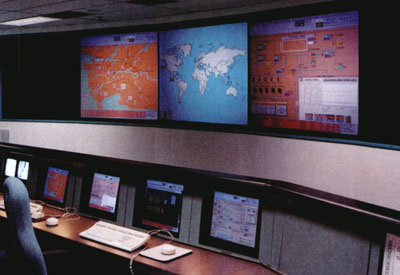Early Use of SCADA

December 12, 2017
Supervisory Control and Data Acquisition (SCADA) technology is nothing new to automation and control experts, who are accustomed to implementing the system using modern technology, but it wasn’t always so. Early integrators faced a variety of challenges, most prominent among them the lack of computing power, particularly with mobile equipment (laptops, tablets, smartphones) that weren’t available in the late 80’s and early 90’s.
However, that does not mean that integration was impossible, and in fact in the early 90’s a number of sectors were getting quite excited about the advancing power of computers and the implications it would have for SCADA. The water industry in particular was an early proponent of the technology.
In this edition of Looking Back we will consider a paper published in the Journal of the American Water Works Association. The article titled Scada trends and integration perspectives was written by Lawrence A. Jentgen and Mark G Wehmeyer in 1994.[1]
The article takes care to fully outline exactly what SCADA is, identifies recent trends that the authors believed would have a significant affect on the future of SCADA system technology, and finally takes a close look at the implementation of the system by the Navajo Tribal Utility Authority. For our purposes we can skip over the definition of SCADA, but we will briefly consider the so-called trends for the future, and will look at the use of the system in the identified case study. The ideas are rather intuitive for 1994, but of course could not wholly understand how fast technology would advance. As we look back at he trends surrounding SCADA 23 years ago consider closely what you know about it today, and just how little we might also know when we think of how far technology may advance in the coming 23 years.
The authors note that “planners of future utility control systems should consider recent trends in five areas of SCADA system technology: (1) high-performance hardware and software, (2) open systems, (3) relational database management systems, (4) utilities communication architecture standards, and (5) digital radio technology.”[2]
The consideration of high-performance hardware and software is an obvious choice to consider for SCADA users particularly in the early 90’s when computers systems were gaining substantial power and were already then greatly improving the price-to-performance ratio of SCADA systems.[3] The increase in CPU power was at the time attributed to the introduction of reduced-instruction-set computer (RISC) and complex-instruction-set-computer (CISC) processors increased the power of central processing units. “The use of high-speed CPU permits the application of high-resolution graphics and computationally intense applications software. The lower cost and reduced packaging allow the distribution of applications such as water models, economic pump control, and historical data storage on multiple computer systems.”[4] Further because of computing power meant clients became more reliable independent hardware and software, a fact that today we take for granted as most of us carry a device in our pocket that has more power than independent computers from the early 90’s.
Open systems are something we are still talking about and in the early 90’s the authors were quick to note how effective industry standards to make components of SCADA systems interchangeable would be.[5] At the time they were still working to fully define “openness” but the authors identified that “open-systems computing has two components – application portability and interoperability.”[6] If we consider their theory than we have largely succeeded. We may not be fully there in terms of standardization cross the board for control and automation components, but advanced technology has made systems and control portable and system integration has significantly advanced interoperability.
We need not go into substantial detail regarding management systems and communication. Suffice it to say our technology and recent advancements in IoT have largely eliminated many of the management and communication issues that were prominent in the past.
It is interesting to look at the application of a SCADA system for the 90’s to identify the hurdles that were faced then and compare them to the challenges of system implementation in today’s world. Below is a selection of the case study from the article on the implementation of a SCADA system.
“New SCADA system designs consider SCADA to be an important way to channel actual utility operating information into an integrated utility management model. This concept of SCADA integration is exemplified by the manner in which the Navajo Tribal Utility Authority (NTUA) approached the design and implementation of its SCADA system. The system’s goal is information integration with other utility information and control systems (e.g., business systems, facility management systems, and distribution automation systems).
The SCADA system will provide the interconnection between the utility systems and the information systems. The NTUA is a combined water, electric, and gas utility that provides service to 24,000 electric, 17,500 water, 7,000 wastewater, and 6,000 gas customers scattered in a 25,000-sq-mi service territory in the Four Corners area where Colorado, Arizona, Utah, and New Mexico meet. The NTUA has seven multiutility districts that provide customer support to the entire Navajo Nation. Implementation of the SCADA system – and ultimately of the integrated utility management system (IUMS) – will enable the NTUA to provide more efficient service to customers. The SCADA system has been designed with a built-in capability for transfer of data between the real-time SCADA system and the information systems. An RDMS with direct access to the SCADA database has been incorporated into the SCADA system, which is also closely coupled with the utility’s AM/FM-GIS capabilities.
The operations center and remote district offices will have access to GlS developed utility maps and facility management information over the SCADA system wide-area network (WAN). The system is designed to operate in an open- systems environment using DEC Alpha processors, a POSIX-compliant operating system, and X-Windows’ MOTIF graphical user interface standards. Intra utility computer communications are over the NTUA’s digital microwave system, and remote sites communicate via 900-MHz radios. To understand how the SCADA project will relate to other existing or proposed NTUA information systems, refer to Figure 7, which reflects the major components of the IUMS. The lower part of the model identifies the three sources of utility data for the SCADA system (water-wastewater, electricity, and gas) and depicts how they are linked to the core of a shared database. This relational database forms the basis for all current and future information integration
The NTUA’s integration of SCADA with its other utility applications is an example of the opportunities that can be realized when SCADA planning considers integration. In many cases, material and human resources can be optimized in the development of utility wide applications.”
Although a variety of challenges have remained the same technology has both made the use SCADA far more viable, but likewise presents a new set of challenges and directions. Panel Builder & Systems Integrator would love to get you opinion on this. Send us your thoughts and considerations, or better write a response piece or an article on the challenges and how you overcome them when working with SCADA system technology.
Send your thoughts or response pieces to: owenhurst@Kerrwil.com
Jentgen, Lawrence A. and Wehmeyer, Mark G. “SCADA trends and integration perspectives,” In American Water Works Association Journal 86 (7) (1994), pp. 44-53
[1] Jentgen, Lawrence A. and Wehmeyer, Mark G. “SCADA trends and integration perspectives,” In American Water Works Association Journal 86 (7) (1994), pp. 44-53
[2] P. 45
[3] P. 45
[4] P. 45
[5] P.48
[6] P.48
















